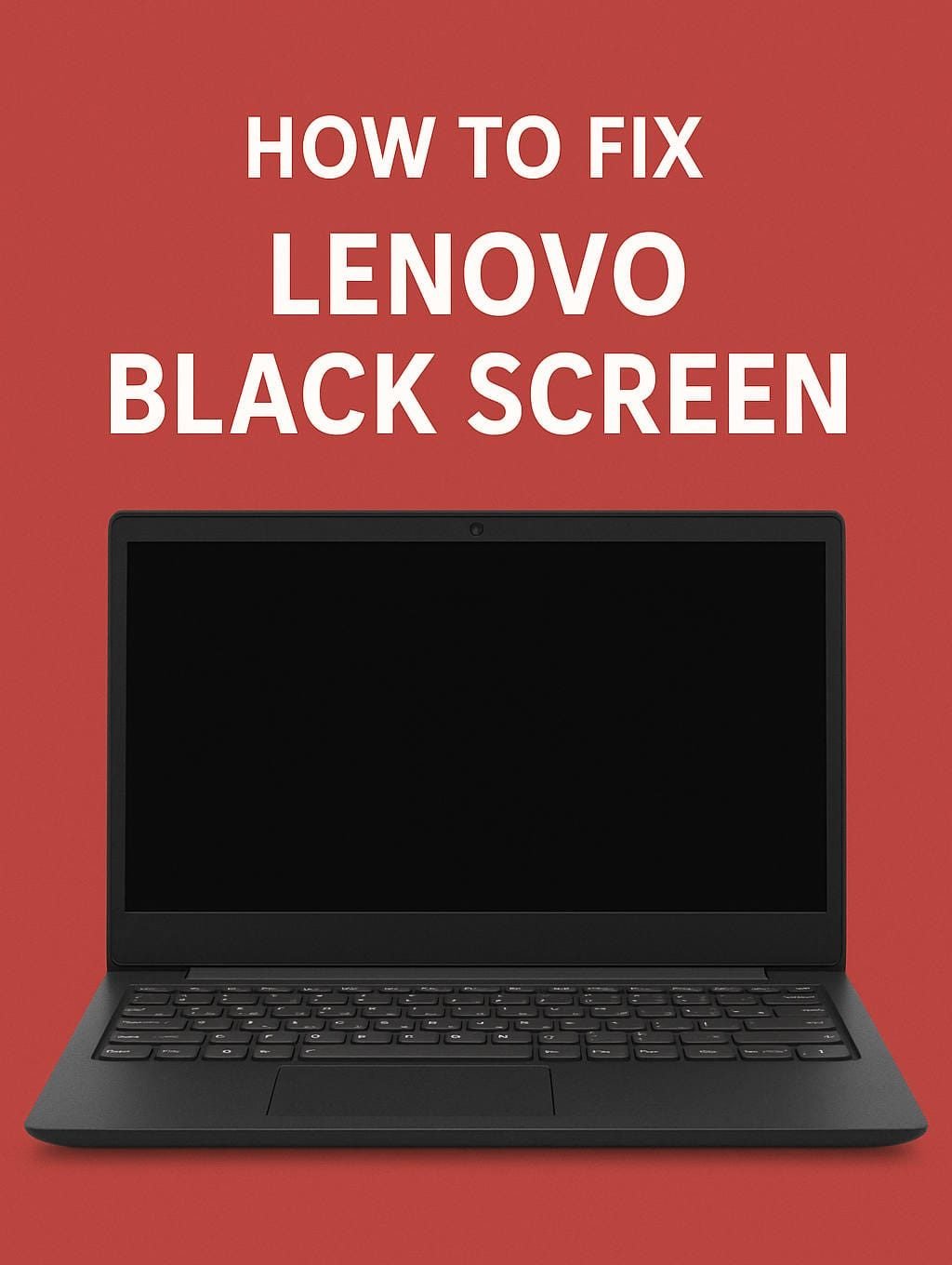Few things are as frustrating as sitting down to use your Lenovo laptop, only to be greeted by a completely black screen. You press the power button, the fans start spinning, the keyboard lights may flash—but the display remains blank. No logo. No loading screen. Nothing. Just darkness.
Whether your Lenovo laptop screen turns black during startup, after login, or randomly during use, the issue can be disruptive. Fortunately, a black screen doesn’t always mean a dead laptop. In many cases, the problem can be resolved with a bit of troubleshooting—either on the software or hardware side.
This post will walk you through every step to identify the cause and guide you toward the right solution. Whether you’re a tech-savvy user or a casual laptop owner, these instructions are beginner-friendly and thorough.
Why Your Lenovo Laptop Screen Is Black
Let’s begin by understanding what might be causing the black screen in the first place. This issue can occur for a variety of reasons, and knowing the likely source can help you apply the correct fix faster.
Here are the most common culprits:
- Display misconfiguration (such as being set to use an external monitor)
- Overheating or sudden hardware failure
- Corrupt graphics driver
- System glitches after Windows updates
- Software conflict or malware
- Hardware issues like faulty screen, GPU, or motherboard
- Loose or damaged display cables
- Issues during sleep or hibernate mode
Sometimes it’s a minor software hiccup, and other times, it might involve internal components. Let’s start with the simplest fixes and progress toward more technical solutions.
First Steps: Basic Checks Before Digging Deeper
Before you get into advanced troubleshooting, try these simple checks. You’d be surprised how often these quick fixes solve the problem.
Check Power and Charging
Make sure your laptop is powered and charging properly. If the battery is dead and not charging, the screen won’t come on.
- Confirm the power adapter is plugged in and connected firmly to the laptop.
- Check for any visible damage to the charger or port.
- Look for LED charging indicators—if they’re off, the laptop might not be getting power.
Test the Brightness Keys
Sometimes, the screen is just too dim to see. Try adjusting the brightness using the Fn + Brightness Up key combination. If it doesn’t work, the backlight may be the issue.
Unplug External Devices
Remove any connected USB drives, external hard disks, HDMI cables, or other peripherals. In some cases, these devices can interfere with the boot process or cause the display to default to another output.
Try a Display Mode Shortcut
Use Windows + P to open display projection options, then press Arrow Up/Down followed by Enter to toggle modes. If your laptop is set to project to a second screen only, your main screen will remain black.
Fix 1: Perform a Hard Reset
A hard reset helps clear temporary hardware conflicts. It’s one of the first things you should try.
Steps:
- Shut down the laptop completely.
- Disconnect the charger and remove the battery if it’s removable.
- Hold the power button for 30 seconds to discharge any remaining power.
- Reconnect the charger (without the battery, if removable).
- Press the power button and check if the screen turns on.
This step can often resolve booting issues that cause a black screen.
Fix 2: Use an External Monitor
To determine whether the issue lies with your screen or graphics system, connect your laptop to an external display.
What You’ll Need:
- An HDMI or VGA cable.
- A monitor or TV with a compatible input.
Steps:
- Plug the external display into the laptop.
- Power on both devices.
- Press Windows + P to switch display modes.
- If you see your screen on the external monitor, the laptop’s built-in display or display cable may be faulty.
If nothing shows up on either screen, the issue may be related to your graphics card, driver, or system firmware.
Fix 3: Boot Into Safe Mode
Safe Mode starts Windows with only the essential drivers. If the black screen is due to a corrupted graphics driver or software conflict, Safe Mode can help isolate it.
Steps:
- Force shut down the laptop by holding the power button.
- Repeat the process three times to trigger Windows Recovery Environment (WinRE).
- Once in WinRE, navigate to:
- Troubleshoot > Advanced options > Startup Settings > Restart
- Press F4 to boot into Safe Mode.
If your screen displays in Safe Mode, a third-party program or outdated driver is likely causing the issue.
Fix 4: Update or Reinstall Graphics Drivers
A corrupted or incompatible graphics driver can cause your Lenovo laptop screen to go black, especially after updates or sleep mode.
Steps (in Safe Mode or on external monitor):
- Press Windows + X and select Device Manager.
- Expand Display adapters.
- Right-click the graphics device and choose Uninstall device.
- Restart the laptop.
Once rebooted, Windows will reinstall a generic display driver. You can later download the correct driver from Lenovo’s support website or the GPU manufacturer (NVIDIA, AMD, Intel).
Fix 5: Reset BIOS/UEFI Settings
Sometimes the BIOS or UEFI firmware settings can cause display issues, particularly if the system is set to boot incorrectly or use an unsupported display configuration.
Steps:
- Turn off the laptop.
- Turn it on and immediately press F1, F2, or Del repeatedly (depending on your model).
- Look for an option like Load Setup Defaults or Restore Default Settings.
- Save changes and exit BIOS.
If the black screen was due to misconfigured boot or display settings, this should resolve it.
Fix 6: Run Lenovo’s Built-In Diagnostics
Lenovo includes helpful tools like Lenovo Vantage or Lenovo Diagnostics that can check for software and hardware problems.
If you can access your system:
- Download Lenovo Vantage from the Microsoft Store.
- Run full system diagnostics.
- Pay attention to display, GPU, and memory results.
If your screen is still black:
Use Lenovo’s bootable diagnostics tool:
- On another PC, visit Lenovo’s support page and create a bootable diagnostic USB drive.
- Insert the USB into your black screen laptop and boot from it (you may need to change boot order in BIOS).
- Run the tests and note any hardware failures.
Fix 7: Remove and Reinsert the RAM
RAM issues can prevent a laptop from booting or showing display.
Caution: This step involves opening your laptop.
Steps:
- Power off and unplug your device.
- Open the back cover using a screwdriver.
- Locate the RAM sticks.
- Carefully remove and reinsert them, ensuring they’re properly seated.
If you have more than one RAM stick, try booting the laptop with only one inserted at a time.
Fix 8: Look for Backlight or LCD Issues
In some cases, the screen is working, but the backlight is dead—making it look like the display is off.
Try this test:
- Shine a flashlight at an angle on the screen.
- Look closely for faint text or images.
- If you can see something, your screen’s backlight or inverter has failed.
In this case, the screen needs to be replaced, or the internal inverter needs repair.
Fix 9: Consider Overheating or Motherboard Problems
If your laptop feels hot or shuts off frequently before the black screen happens, overheating could be damaging internal components.
Signs of hardware failure include:
- No fans spinning
- No boot sounds
- Keyboard lights not working
If you’ve tried all other fixes and there’s still no display, a faulty GPU or motherboard might be the issue.
When It’s Time to Call a Professional
There are situations where DIY troubleshooting reaches its limit. If your laptop is under warranty or the fixes above haven’t worked, it’s time to reach out to Lenovo support or a certified technician.
Common indicators that professional repair is needed:
- Cracked or physically damaged screen
- Burnt smell or visible damage inside
- Power button doesn’t respond
- You’ve tried everything and nothing works
Lenovo offers mail-in and in-store support options for most regions. Make sure to check your warranty status before paying out-of-pocket.
Tips to Prevent Black Screen Issues in the Future
Preventing future issues starts with proper maintenance and usage. Here are a few proactive tips:
- Keep your system updated: Regularly check for Windows, BIOS, and driver updates.
- Clean the vents: Overheating is a common issue; clean dust from vents and use a cooling pad if needed.
- Avoid abrupt shutdowns: Force shutting down can corrupt system files.
- Use antivirus software: Malware can cause display issues and system crashes.
- Handle your laptop carefully: Avoid dropping or putting pressure on the screen.
- Use a surge protector: Protect your device from power surges that can damage internal components.
Final Thoughts
A black screen on your Lenovo laptop doesn’t have to mean disaster. In many cases, it’s the result of something minor, like a display setting or a driver error. By methodically working through the steps above, you can rule out temporary glitches, fix driver problems, and even identify hardware faults.
The most important thing is to stay calm and start with the basics. From resetting the laptop to connecting an external display or booting into Safe Mode, there are plenty of ways to restore your screen. If you’ve tried everything and still see no display, professional help is just a call or visit away.
Whether you’re using your Lenovo laptop for work, school, or gaming, getting the screen back up and running quickly is key—and now, you have the tools and know-how to make it happen.

